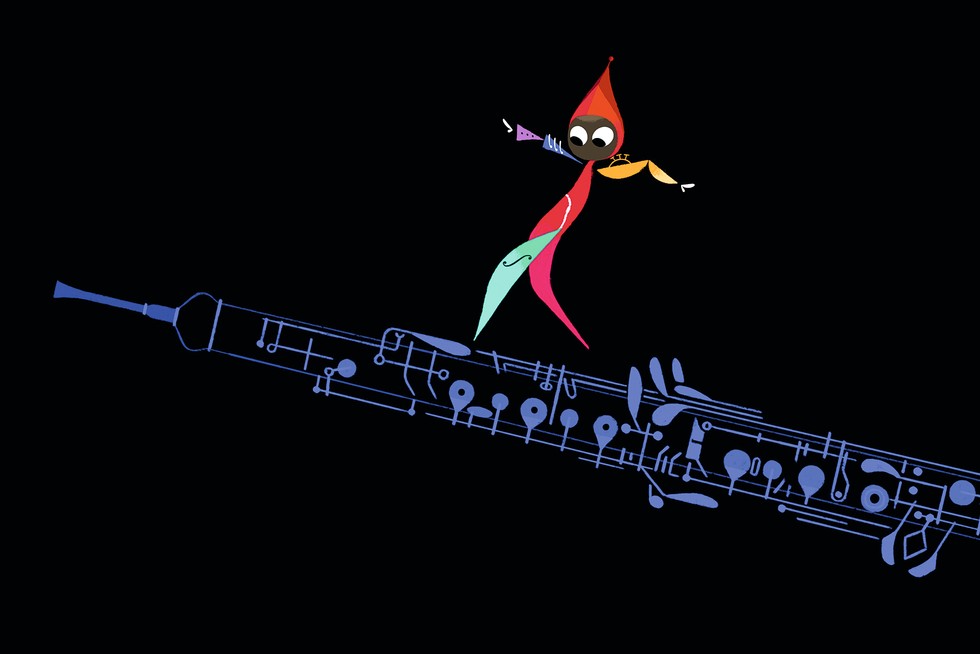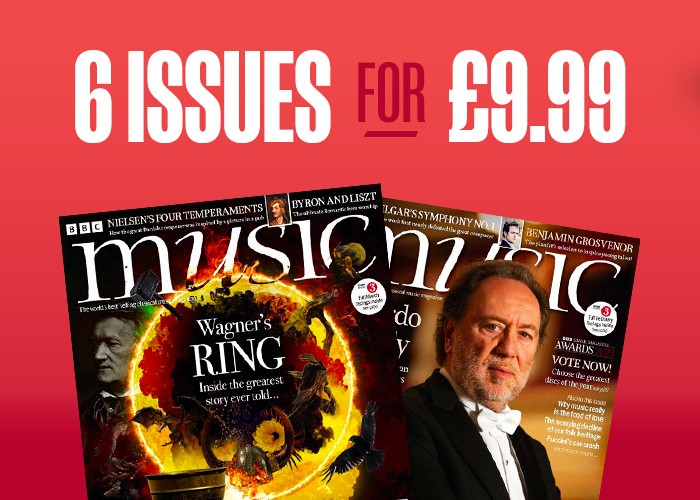Philharmonia Fantastique: an orchestral odyssey
In the footsteps of Prokofiev and Britten, with assistance from a sprite and an A-list team, American composer Mason Bates has created a new audiovisual guide to the orchestra; he explains all to Tom Stewart

As the camera pans from orchestra to audience in the final scene of Tár, we learn just how far the mighty conductor has fallen. We first met her many indiscretions earlier, as she was preparing to record a complete cycle of Mahler symphonies with the Berlin Phil. Now she finds herself directing a provincial performance of music from a video game, with a giant projection screen behind the orchestra, players wearing click-track headsets and an audience done up in elaborate fantasy cosplay.
In reality, live orchestral performance has found necessary new eyes and ears in recent years thanks to events just like the one we’re invited to scoff at in Tár. But does this offer anything to artists beyond boosted revenues? US composer Mason Bates certainly thinks so. His audiovisual guide to the orchestra, Philharmonia Fantastique, uses the same set up and, later this month, will receive its European premiere by the Aurora Orchestra at London’s Southbank Centre.
‘Orchestras have really locked down a new medium with the projections and the click tracks,’ Bates tells me from his studio outside San Francisco. ‘I thought it would be really fun to write for it specifically, rather than just seeing them do Home Alone or something every year.’
Philharmonia Fantastique was first performed last spring and recorded by the Chicago Symphony Orchestra, one of the six American ensembles that first commissioned it (the others being Dallas Symphony Orchestra, National Symphony Orchestra, Pittsburgh Symphony Orchestra, San Francisco Symphony and the American Youth Symphony). The 25-minute work comprises a ‘concerto for orchestra’ with live electronics and a charming animation, projected behind the players, of a two-dimensional ‘sprite’ who goes on a magical mystery tour of the instruments on stage.
‘Animation is the perfect medium for showing people the way the orchestra works,’ says Bates. ‘There’s so much technology involved – what happens when you push down the valve on a tuba, or press the pedal on a timpani? I had to think very carefully about how to show all this in the music at the same time as making sure everything still made musical sense.’
The animation was led by Jim Capobianco, whose previous credits include Pixar’s Oscar-winning Ratatouille as well as The Lion King and Finding Nemo. It was directed by Gary Rydstrom, whose seven Oscars include Best Sound for Titanic
and Jurassic Park.
The orchestra is a complex being that can take a little explaining for the uninitiated. The two best known works that do this are Prokofiev’s 1936 Peter and the Wolf and A Young Person’s Guide to the Orchestra, which Britten wrote in the months immediately following World War II. In between came Fantasia, Walt Disney’s 1940 animated feature that brought composers from Bach to Musorgsky to the attention of the cartoon-watching public. All three have endured, but the Prokofiev in particular is regularly re-recorded with new celebrity narrators: you can watch Viola Davis on YouTube with the LA Phil and Gustavo Dudamel in 2021, for example. As Bates points out, however, there hasn’t been a new work like these ones for quite some time.
Like Fantasia (and unlike the others), Philharmonia Fantastique is a wordless work that relies on the animation, live-action shots of the players and the score itself to tell the story. The music erupts from a glittering, primordial soup of sound, the players racing up and down the harmonic series and, on screen, a stave stretching out ahead of the audience like the famous opening of the Star Wars films.
Bates’s music is slick and shiny – it’s an exciting, action-packed score with nothing to scare anyone off and plenty to keep young ears engaged. The same goes for Capobianco’s playful and colourful animation. ‘As I was writing the music, I was constantly communicating with Jim about what visuals he thought could work,’ Bates says. ‘I’d never really storyboarded anything like that before, but he would be sitting there scribbling all these different sketches. There’s a moment when Sprite goes inside the flute and I remember Jim asking how she got there – did she trip and fall or did she climb in out of curiosity? It felt like a minute detail, but he was trying to figure out the motivation of the character on screen, which then helped me create a sound and a motivation for it in the score.’
When Britten was asked if he adapted his musical language for the young audience of his 1945 score, he responded that he ‘never really worried that it was too sophisticated for kids – it’s difficult to be that for the little blighters’. When I ask Bates the same question, he says that Philharmonia Fantastique ‘had to have a kind of clarity to it’. His solution was to give each section of the orchestra its own distinct sound. ‘You had to be able to hear when the families started to sing each other’s tunes, to speak each other’s tongues,’ he says. ‘I wanted those interactions to be obvious – the music couldn’t just be underscoring what you can see on screen. I wanted to connect the orchestra to different sides of contemporary life.’ There’s ‘film noir’ for the woodwinds, he says, and ‘drum corps’ for the percussion. Then comes the romantic, lyrical string writing, and techno brass that reminds me of when a military band at the 2017 Bastille Day celebrations played a medley of songs by Daft Punk.
Bates was born in Philadelphia in 1977 and studied composition at Juilliard with Samuel Adler, John Corigliano and David Del Tredici. When he was in New York, he began to try his hand at DJ-ing, though it wasn’t until he moved to California, aged 21, that it began to play a more important role in his musical life. ‘San Francisco was a total party town,’ he says. ‘It was during the tech boom and basically every space in the Bay Area had a DJ playing in it. For a while it was just something I did on the side, but later I began to integrate it into the other things I was writing.’
Nowadays, the pops and crackles of a drum machine might be the most characteristic electronic sound in Bates’s scores – listen to Philharmonia Fantastique for an idea of how they permeate the textures – but there’s much more besides. ‘If you have speakers set up on stage then you can have whatever sounds you want. You can have a recording of a spacewalk from the outer atmosphere or something from the bottom of the ocean.’ It was the latter he drew on for Whalesong, commissioned by the BBC and given its first performance at last year’s CBeebies Prom.
The addition of electronic sound design gives Bates’s already glossy and confidently constructed scores an extra layer of polish. Where Philharmonia Fantastique is concerned, comparisons with A Young Person’s Guide to the Orchestra are difficult to resist, and one here might help to illuminate things for anyone who hasn’t heard Bates’s music before. Structural and conceptual differences aside, it’s a bit like hearing Britten through the prism of one of Bates’s early noughties Bay Area DJ sets. The younger composer’s affinity with Californian culture is clearest in his 2017 opera The (R) evolution of Steve Jobs,
an account of the Apple founder’s life. ‘It was the stuff of opera,’ Bates says. ‘He lived in such an intensely artistic white heat; there was so much passion, betrayal and obsession. All the animalistic elements you need for an opera were there already.’
The (R) evolution of Steve Jobs has been programmed multiple times since its first run, while the Santa Fe Opera’s recording of it won the 2019 Grammy Award for Best Opera recording. ‘I think one of the reasons the piece has done so well is that the medium of opera allows you to get closer to the essence of a story than, say, film, which is so much more representational,’ says Bates, adding that it may also have something to do with the fact so many of us use Apple technology on a daily basis. ‘We all carry him around in our pocket,’ he says.
That may be true, but does Bates feel a more personal connection to Jobs? ‘Absolutely. It was almost meta-fictional, doing all this work in a studio filled with Mac equipment,’ he says. ‘Steve Jobs’s basic vision was that you’d have almost no division between your thinking and the device you’re holding, almost as if it was a musical instrument. That part really resonated with me.’ In some ways, that’s what Philharmonia Fantastique is doing too: revealing function via form and blurring the line between the two, all the while looking and sounding stylish.
The film of Philharmonia Fantastique is released on Platoon, and available to watch on Apple Music now.
The Aurora Orchestra will give the work's UK premiere on 16 April at London's Southbank Centre.




